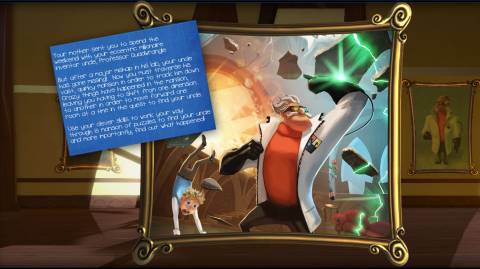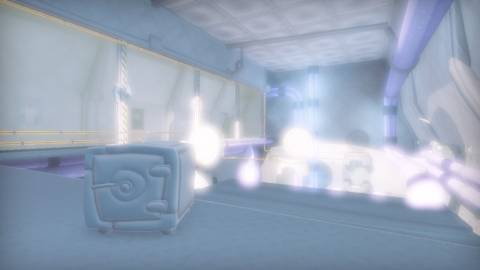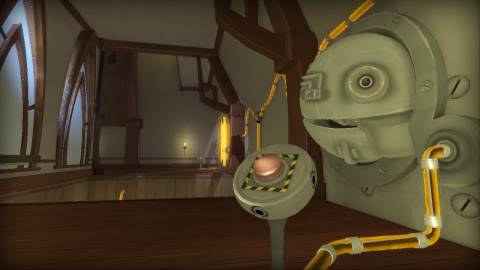I sometimes question what, exactly, it is we want from game developers. We claim to cherish originality, to herald new IPs and design concepts as if we wished them to be the sole focus of our development community. And yet, when we look at the sales, we look at the games that frequently dominate the conversation from year to year, it's always the sequels, reboots, and other things bearing the unmistakable stamp of "That Thing You Already Like" that seem to float straight to the top. It takes a rare, powerful brand of creative new IP to actually impress the gaming audience beyond the scope of the usual indie kids and auteurs-in-training.

Portal was one such game. Designed by Kim Swift (and her cohorts at Valve), Portal broke free of the chains often imposed upon new properties, thanks in no small part to Valve's clever marketing (including the title as part of the popular Orange Box package certainly helped), wonderfully addictive puzzle designs, and a charmingly bleak sci-fi story line that helped propel it into the stratosphere of video game culture. Perhaps unsurprisingly, given the audience's aforementioned love of familiarity, Portal 2, at last check, had sold in the neighborhood of three million copies.
Swift didn't work on Portal 2. She was involved in a variety of different projects at Valve, but eventually opted to leave the company in late 2009 for a new job at Airtight Games. The fruits of that new position wouldn't be known until just before PAX earlier this year. This new game, Quantum Conundrum, features a protagonist trapped in a topsy-turvy world of science gone amok, forced to use dimension-shifting technology to manipulate the environment, physics, and a lot of square objects, with only the occasional help of a pet A.I. to aid them in their quest through this bizarre, potentially lethal scientific labyrinth.
Sound familiar?
It apparently did to a lot of commenters. On the debut trailers, promo videos, and news stories pertaining to the game's announcement, actual discussion of the game's merits seemed choked out by the thick, noxious fumes of direct, irritated Portal comparisons. Which isn't to say that those comparisons aren't without merit--in some respects, the two games do have direct similarities--but the negative tone with which many of those comments came across was vaguely baffling. Here is a game that, in some respects, closely resembles one of the best puzzle/adventure games of all time. One designed by the woman who designed that very game, no less. What, exactly, are people flipping out about?

One gets the impression that Swift would just as soon not give any credence to anyone who would complain about such a thing. I noted during a recent preview session with her that it seemed she had a particular fancy for things like "mad-science-based puzzles, room-based puzzles, helpful robots, and square things," and her response was what one might call defensively affirmative. "Yes! They're fun. Why would I not want to make more fun?" She also pointed out that lots of puzzle games have square things. Fair enough.
In short, Swift has her thing. She has things she likes, and those things translate into her games. Seems fair, right?
It might be easier to criticize Quantum Conundrum for its derivations were it not so damn neat-looking. Though the story elements still aren't being shown (the demo we saw was an older one, and the game doesn't hit until early next year), we know of the premise involving you, a 12-year-old boy who finds himself trapped in the crazy, kooky home of his professorial uncle, Fitzgerald Quadwrangle. Quadwrangle has gone missing somewhere in this absurd laboratory/home, and it's up to you to find him. Unfortunately, obstacles lie in your way, ones that can only be traversed with the aid of a dimension-shifting glove, which allows you to do a variety of odd things, like turn everything in the room "fluffy," shift gravity up and down, and slow down time to a Michael Bay-ian crawl.
Unsurprisingly, you will find yourself combining these various abilities (including an as-yet-unrevealed fourth ability) in concert to find your way through this bizarre house. Your primary object of movement (though there are others) tends to be a giant, blocky safe, often barfed out by the house's helpful A.I. DOLLY (whose bulbous head closely resembles a cross between the Tin Man and an Ugly Doll). Sometimes they have to be placed on switches, launched across a room, used to break apart walls/windows, or all of the above. Hence the dimensional shifting. If the safe needs to be lifted, use the fluffy dimension. If it needs to break something, launch via fluffy, then switch back to normal. If it needs to go upside-down, use reverse-gravity. Need to use a safe as a platform, go to fluffy, launch, then normal, and to slow-motion.
Much as Portal was about finding ways to using your two portals (and sometimes those ill-fated companion cubes) to get you from point A to point B, Quantum Conundrum is about figuring out which combinations of dimensional shifts to put together to solve a particular room's weirdness. Over the course of the game's six-hour-or-so campaign, the trickiness of said puzzles will ramp up accordingly, culminating in some truly crazy brain-twisters (but probably not an antagonistic battle with DOLLY).

If you were one of those people who found Portal a bit too scratchy for your particular noodle, you might find Quantum Conundrum's hint system particularly useful. Swift was quick to clarify that this dynamic system, which looks at where you are in a room and feeds in information courtesy of your Uncle Quadwrangle over a loudspeaker, does not give away the answer, but rather suggests a place to look or an area to move toward to perhaps point you in the right direction.
"I'm the writer, and I watch playtests," she said, "And I know why people are getting stuck. Like in one area, we often find people fundamentally have trouble realizing to look up. You have to throw every tool at them to get them to look up, flashing lights, sound, everything. So I have a timeout area where if they've been in this area for a long time and they haven't done this one thing, then I can assume they are stuck here for this reason. All of our hints are custom-tailored per map, based on watching players playtest." That Valve mentality of "playtest, playtest, playtest" seems to have stuck with Swift, along with a few other things.
Whatever comparisons you may feel apt to make regarding Quantum Conundrum, do so with the understanding that we are in an industry built almost exclusively on rip-offs and pantomime. Think of the sheer volume of also-ran platformer heroes, military shooters, sci-fi strategy games, and gritty, dark action games we've been firehosed with over the last few decades. If Kim Swift wants to make a game that looks like a Kim Swift game, and that game looks as much fun to play as Quantum Conundrum, I say godspeed to her and her journey, and sign me up when the game releases on Xbox Live Arcade, the PlayStation Network, and Steam in 2012. I can always use a few more hours of whimsical puzzle-solving in my life.